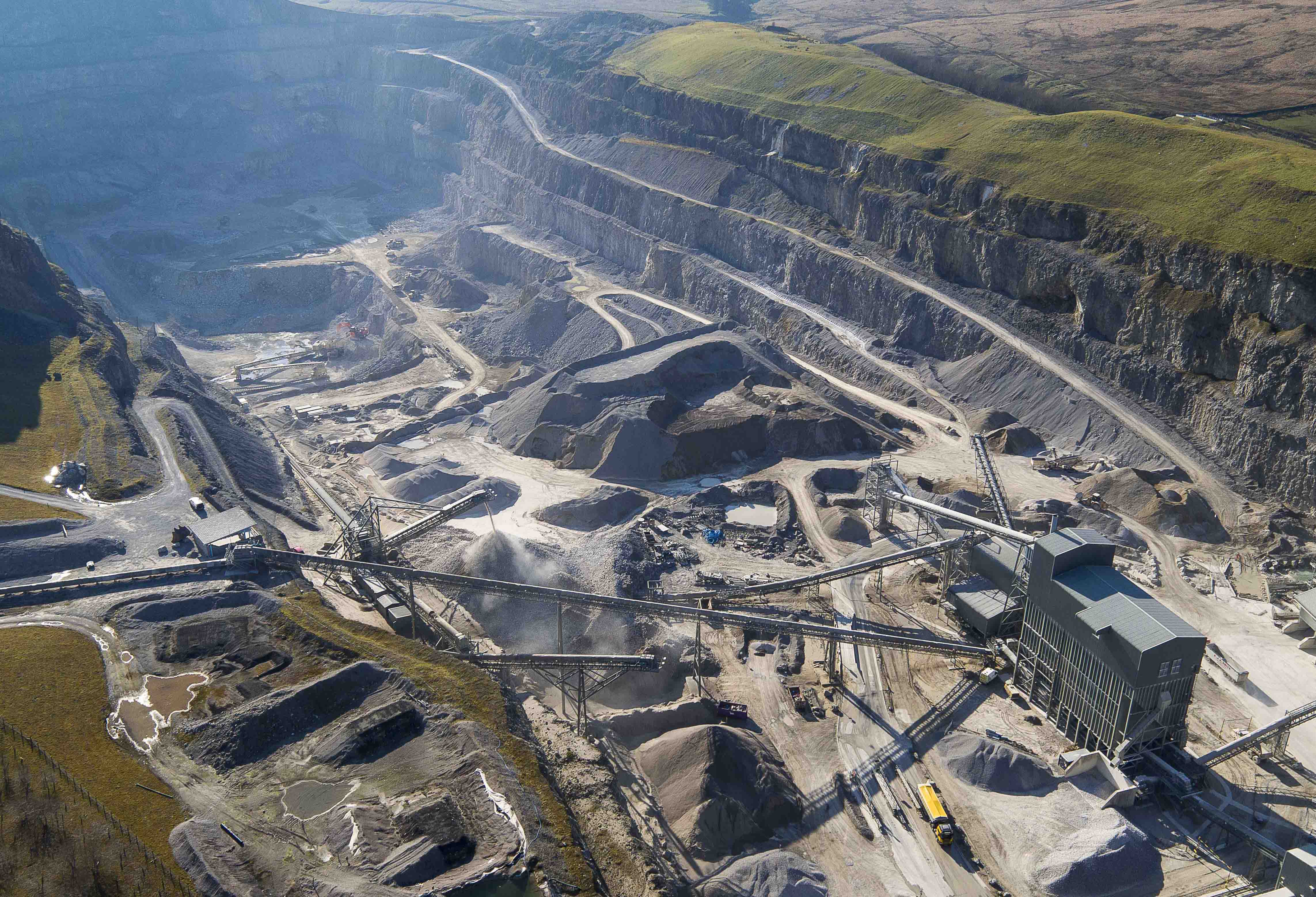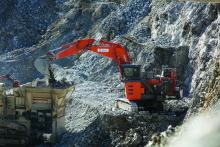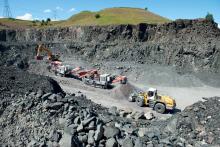
While the UK growth forecast for 2016 is down to 2% from 2.6% due to the Office for Budget Responsibility (OBR) reducing its forecast of British productivity, and despite the UK economy’s growth over the next five years not expected to be as high as forecasted in November 2015, the British aggregates sector is in buoyant shape compared to just about anywhere else in Europe. Guy Woodford reports
According to the most recent
The UK has 716 aggregate producers (companies) – half the number of Germany (1,481) and France (1,454) – and 1,342 extraction sites (quarries and pits) – more than half the number of Germany (2,960); and nearly half the number of France (2,530).
The single biggest UK produced product is crushed rock: 113 million tonnes/year; followed by recycled aggregates: 51 million tonnes/year; and sand and gravel: 49 million tonnes/year.
A key new report released in February 2016 shows how critical the UK mineral extraction industry, particularly the non-energy sector, is to the British economy.
Prepared by the
By looking at historical and current production patterns this report illustrates that minerals are essential, providing the foundations for every sector of the economy by supplying vital raw materials at the heart of UK growth.
New findings in the MPA compiled report also reveal that UK Minerals extraction generates a turnover of €19.8 billion (£15 billion), and €6.6 billion (£5 billion) in Gross Value Added (GVA). Furthermore, minerals extraction directly employs 34,000 people, and supports 4.3 million jobs through its supply chain.
MPA member sales of construction materials were generally positive in 2015, although all materials other than ready-mixed concrete (RMC) saw more modest growth than in 2014.
Sales of aggregates increased by 4.8% compared to 2014, whilst RMC sales accelerated in 2015 (+4.2%) compared to 2014 (+3.6%), increasingly influenced by infrastructure projects, with more modest contributions from housing. Reflecting slower housing activity throughout the year, mortar sales grew by 1.3% in 2015, after a 19% increase in sales volumes in 2014. Asphalt sales grew by 6.5% in 2015, boosted by faster than anticipated roads spending, but declined in the last quarter of 2015. Regionally, 2015 was a particularly strong year for the industry in Scotland, largely due to the timing of major projects.
MPA member sales represent around 80% of the total British market for aggregates, 75% of the RMC market and 90% of the overall asphalt market.
An example of the health of British aggregate demand can be found in
A leading UK-based producer of aggregates, asphalt and ready-mixed concrete for builders, Breedon said its pre-tax profits in the year to December 31 rose 46.4% to £31.3 million (€40.4 million) with an 18.1% increase in revenue to £318.5 million (€411.3 million).
During the year, the group finalised its biggest contract, the £55 million (€71 million) Aberdeen Western Peripheral Route roadbuilding joint venture, and agreed, subject to CMA approval, to buy Hope Construction Materials in county Derbyshire, England for £336 million (€433.9 million).
In their jointly presented Review of 2015 accompanying Breedon’s record trading figures, the company’s executive chairman Peter Tom and former chief executive now non-executive director Simon Vivian note the UK Government’s commitment to infrastructure investment, such as Crossrail and HS2, and all the relevant forecasting bodies predictions of modest but sustained growth in construction over the next few years.
But the pair also acknowledge that “domestically, the EU referendum could also have an adverse effect on growth.” There is also concern over declining aggregate reserves.
The MPA’s fourth Annual Mineral Planning Survey (AMPS4), covering MPA members’ data to December 2014, found that replenishment of sand and gravel is being “severely under– replenished as reserves are used twice as fast as new capacity is being permitted”. The Survey also found that “crushed rock is superficially being replenished, but this is skewed by a few large permissions which mask general under-replenishment elsewhere”.
Announcing the publication of AMPS4, MPA chief executive Nigel Jackson said: “The report highlights the fact that insufficient new reserves are being permitted particularly sand and gravel and this continues to be a real concern. With over half of new permissions being for sites that have not yet been allocated in mineral plans, it is clear that the plan led system is not providing the certainty that it should.”
Like Britain, the Ireland’s aggregates market offers much encouragement for sector operators. Irish building materials giant CRH saw its pre-tax profits rise a healthy 36% to €1.03 billion in 2015.
The company’s US sales benefitted from a weaker euro, and management expect the favourable exchange rates that helped boost last year’s profits to continue in 2016.
CRH’s American businesses, which are mainly focused on the US, contributed €917 million to its €1.27 billion operating profits in 2015. Last year’s global CRH sales were worth €23.6 billion - 25% up on the €18.9 billion achieved in 2014. The company’s EBITDA was up 35% in 2015 to €2.2 billion, compared to €1.6 billion the previous year.
“As a result of good performance from our heritage businesses and contributions from acquisitions, 2015 was a year of significant profit growth for CRH,” said CRH chief executive Albert Manifold.
He added: “Strong cash generation resulted in our yearend debt metrics being ahead of target, and we are well on track to restoring these metrics to normalised levels during 2016.
“Recently there has been some uncertainty about the pace of global growth. Our focus remains on consolidating and building upon the gains made in 2015, and against this backdrop we believe 2016 will be a year of continued growth for the group.”
Manifold’s confidence in continued growth for CRH was well founded given the company’s Q1 2016 trading. Overall group revenues were up year-on-year 9% in the quarter, with a 22% rise in its American segment and a 12% increase in Asia. The building material firm also spent €85 million on investments and takeovers while selling €78 million worth of assets in the first three months of 2016.
Back in the UK, the latest quarrying equipment is in demand among many leading aggregate material producers.
The EX1900-6 is used to load up to 1,200tonnes of carboniferous limestone/hour directly into a 200-tonne mobile crusher. A field conveyor takes the material to a secondary crusher at an average rate of 1,000 tonnes per hour.
Swinden Quarry produces various sizes of aggregates, from 100mm down to dust (including grades of 80, 40, 28, 20, 14, 10 and 6), which are dry stored in silos. The material is either directly transferred to the site’s rail siding via a conveyor to the fully automated lorry load-out, or into the ‘toast rack’ storage, from which a wheel loader can directly load customers’ trucks. Approximately 60% of the materials are transported by rail to Tarmac’s dry distribution centres in Leeds, for onward transportation to South Yorkshire, and a depot in Hull. Much of the limestone is used in Tarmac’s concrete and asphalt plants in the north of England.
With the arrival of the EX1900-6, Tarmac intends to maintain its current production levels and annual output of 2.3 million tonnes.
Mark Turnham, Mines & Quarries manager at Hitachi Construction Machinery (UK), said: “Following years of under investment, due to the economic downturn, quarries in the UK are increasing their investment in new equipment.
Customers are focusing increasingly on machine efficiency and productivity. Hitachi large and ultra-large excavators are recognised for their reliability and efficiency in this market.”







